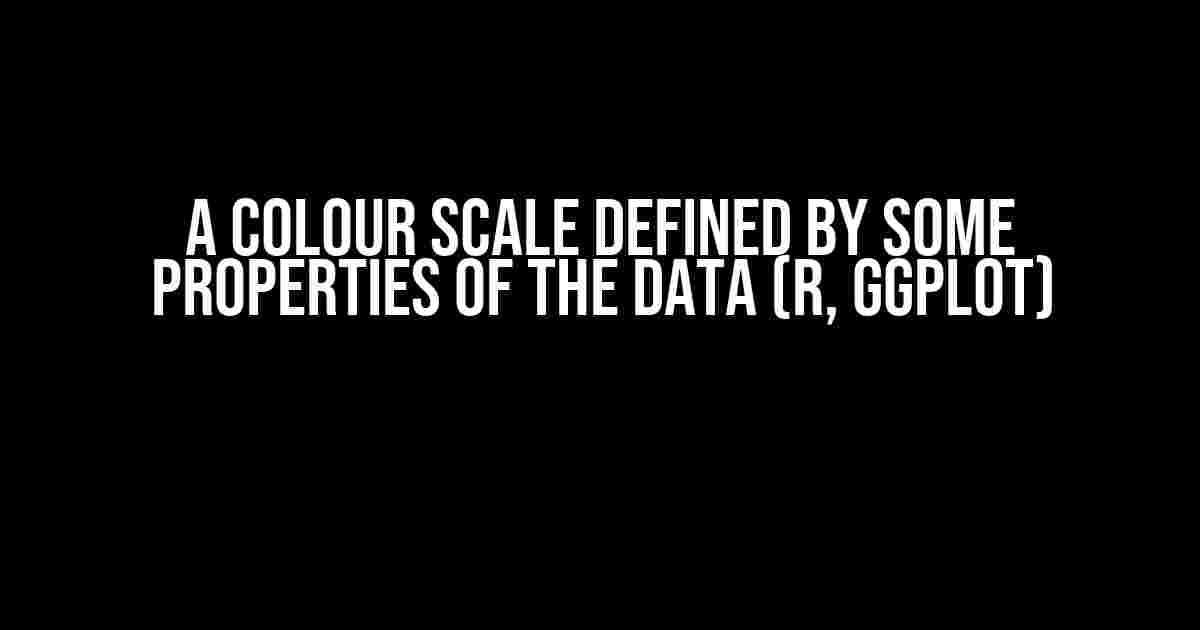Welcome to the world of data visualization, where colours play a crucial role in conveying insights and meanings! In this article, we’ll delve into the realm of colour scales, specifically focusing on how to create a colour scale defined by some properties of the data using R and ggplot. Buckle up, folks, and get ready to unlock the secrets of visually stunning data visualizations!
What is a Colour Scale?
A colour scale, also known as a colour palette or colour map, is a range of colours used to represent different values or categories in a dataset. In the context of data visualization, a well-chosen colour scale can make or break the effectiveness of a graphic. A good colour scale should be:
- Perceptually uniform: The colours should be evenly spaced and easy to distinguish from one another.
- Meaningful: The colours should convey relevant information about the data, such as trends, patterns, or categories.
- Aesthetically pleasing: The colours should be visually appealing and harmonious.
Why Define a Colour Scale by Data Properties?
Defining a colour scale by some properties of the data offers several advantages:
By linking colour to specific data features, you can:
- Highlight patterns and relationships in the data that might otherwise go unnoticed.
- Create more accurate and informative visualizations.
- Enable users to quickly identify and understand the data insights.
Preparing Your Data for a Custom Colour Scale
Before diving into the world of colour scales, make sure your data is in order! Here’s a quick checklist:
- Load your dataset into R.
- Verify that your dataset has a suitable structure for the type of visualization you want to create (e.g., a data frame for a scatter plot).
- Ensure that the variables you want to use for the colour scale are numeric or categorical.
Creating a Custom Colour Scale with ggplot
Now, let’s get started with creating a custom colour scale using ggplot! We’ll use the built-in scale_colour_gradient() function to define a colour scale based on a specific data property.
library(ggplot2)
# Sample dataset
df <- data.frame(x = runif(100), y = runif(100), z = runif(100))
# Create a scatter plot with a custom colour scale
ggplot(df, aes(x = x, y = y, colour = z)) +
geom_point() +
scale_colour_gradient(low = "blue", high = "red", midpoint = 0.5)
In this example, we're creating a scatter plot where the points are coloured based on the values in the z column. The scale_colour_gradient() function takes three main arguments:
low: The colour for the lowest values in the dataset (in this case, blue).high: The colour for the highest values in the dataset (in this case, red).midpoint: The value at which the colour scale changes from the low colour to the high colour (in this case, 0.5).
Customizing Your Colour Scale
The scale_colour_gradient() function offers a range of customization options to fine-tune your colour scale. Here are a few examples:
# Add a colour midpoint
ggplot(df, aes(x = x, y = y, colour = z)) +
geom_point() +
scale_colour_gradient(low = "blue", high = "red", midpoint = 0.5, mid = "yellow")
# Use a diverging colour scale
ggplot(df, aes(x = x, y = y, colour = z)) +
geom_point() +
scale_colour_gradient2(low = "blue", mid = "white", high = "red")
# Create a discrete colour scale
ggplot(df, aes(x = x, y = y, colour = factor(z))) +
geom_point() +
scale_colour_discrete(breaks = c("Low", "Medium", "High"), values = c("blue", "yellow", "red"))
Colour Scale Best Practices
When creating a custom colour scale, keep the following best practices in mind:
- Choose colours that are accessible and easy to distinguish for users with colour vision deficiencies.
- Avoid using 3D or bright colours, as they can be overwhelming and difficult to read.
- Limit the number of colours used in a single visualization to avoid visual clutter.
- Use a consistent colour scale throughout a series of visualizations to facilitate comparison and understanding.
Conclusion
And there you have it, folks! With this comprehensive guide, you're now equipped to create a colour scale defined by some properties of the data using R and ggplot. Remember to keep your colour scales meaningful, aesthetic, and user-friendly, and don't be afraid to experiment and customize to your heart's content.
Happy visualizing, and see you in the next article!
| Keyword | URL |
|---|---|
| A colour scale defined by some properties of the data (R, ggplot) | https://example.com/article |
Related articles:
- Data Visualization 101: A Beginner's Guide
- Mastering ggplot: Essential Functions and Techniques
- The Art of Colour in Data Visualization: Theory and Practice
Frequently Asked Questions
Get to know the ins and outs of a colour scale defined by some properties of the data in R and ggplot!
What is a colour scale in R and ggplot?
A colour scale in R and ggplot is a way to map data values to colours. It's a powerful tool that helps you visualize and communicate insights in your data. You can use colour scales to represent different variables, highlight patterns, and create stunning visualizations!
How do I create a colour scale in R?
In R, you can create a colour scale using the `scale_color_` or `scale_fill_` functions from ggplot2. For example, `scale_color_continuous()` creates a continuous colour scale, while `scale_color_discrete()` creates a discrete colour scale. You can customize the colour scale by specifying the limits, breaks, and colours!
What are some common colour scales used in ggplot?
Some popular colour scales in ggplot include Viridis, Inferno, and Plasma. These scales are perceptually uniform, meaning they're easy on the eyes and help you spot patterns in your data. You can also use built-in scales like `scale_color_brewer()` or create your own custom scales!
How do I customize a colour scale in ggplot?
You can customize a colour scale in ggplot by adding arguments to the `scale_color_` or `scale_fill_` functions. For example, you can specify the limits using `limits = c(min, max)`, set the breaks using `breaks = c("label1", "label2", ...)`, or even create a custom colour palette using `scale_color_manual(values = c("colour1", "colour2", ...))`!
Can I use a colour scale to represent multiple variables in ggplot?
Yes, you can use a colour scale to represent multiple variables in ggplot! One way to do this is by using the `scale_color_gradientn()` function, which allows you to map multiple variables to a single colour scale. You can also use `facet_wrap()` or `facet_grid()` to create separate panels for each variable. Get creative and experiment with different approaches to find the one that works best for your data!


